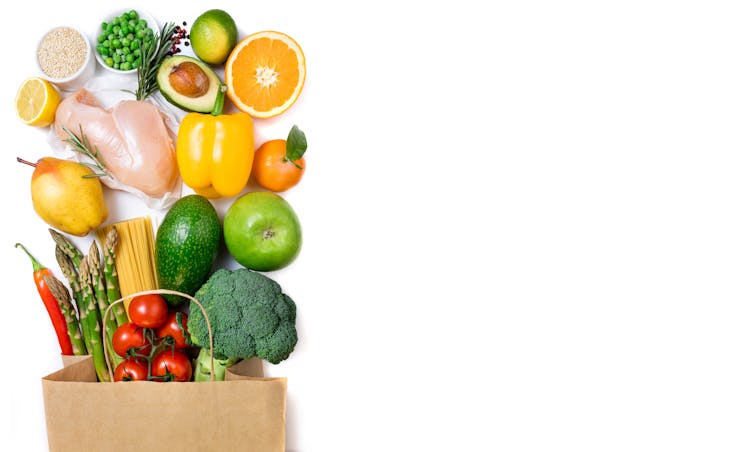The Paleo Diet urges us to mimic our prehistoric ancestors’ food choices. In practice, this means eschewing dairy products, cereals, pulses and processed sugar, and consuming vegetables, fruit, nuts, pasture-raised meat and wild-caught seafood instead.
The Paleo Diet’s proponents contend that by eating this way, we will lose weight and reduce our risk of chronic diseases.
The roots of the Paleo Diet can be traced to the 1950s, but it owes its current popularity to a book by Loren Cordain called The Paleo Diet: Lose Weight and Get Healthy by Eating the Food You Were Designed to Eat, the first edition of which was released in 2001.
In the 22 years since the publication of Cordain’s book, the Paleo Diet has been adopted by several million people and a multi-billion dollar industry has developed in connection with it, including premium-priced foods and a certification scheme.
The Paleo Diet’s health claims

While the Paleo Diet has many adherents, clinical research has yet to substantiate its purported health benefits.
To begin with, it does not seem to outperform conventional recommended diets as a means of losing weight in the medium- to long-term. The only published multi-year study to have evaluated the Paleo Diet’s impact on weight loss found that following the Paleo Diet was no more effective than following the Nordic countries’ official nutrition recommendations after two years.
It is a similar story with the claims that have been made about the Paleo Diet’s impact on chronic diseases. For example, a recent review found that studies examining the Paleo Diet’s impact on Type 2 diabetes have been “inconclusive.”
Similarly, the authors of a 2020 study reported that following the Paleo Diet resulted in a higher relative abundance of gut bacteria that produce a chemical associated with cardiovascular disease, which is at odds with the claim that the Paleo Diet will reduce the probability of experiencing chronic diseases.
Why have the health benefits claimed for the Paleo Diet not been supported by clinical research? As evolutionary anthropologists, we think the problem is that the Paleo Diet is based on a flawed premise and faulty data, and in what follows we’ll try to show why our research brought us to this conclusion.
A flawed premise
The idea underlying the Paleo Diet is that the ongoing surge in obesity and associated diseases in many countries is the result of a mismatch between the foods we eat and the foods our species evolved to consume.
This mismatch, so the argument goes, is a consequence of there having been too little time since agriculture appeared, 12,000 years ago, for evolution to have adapted our species to deal with a high-carbohydrate, low-protein diet or to process domesticated food.
This argument seems reasonable because there is a perception that evolution is a very slow process. However, it is not in fact supported by research on diet-related genes.

Work on lactase persistence — the continued ability to produce the enzyme lactase as an adult — illustrates this. Lactase enables us to digest the milk sugar lactose, so lactase persistence is useful for a diet involving dairy products. Lactase persistence is found in just a few regions, one of which is Europe. Ancient DNA research indicates that lactase persistence is less than 5,000 years old in Europe.
Similarly, an analysis of genetic data from African populations published last year found evidence of recent adaptation in a family of genes connected with metabolizing alcohol. In this case, natural selection operated within the last 2,000 years.
This evidence shows the mismatch rationale for adopting the Paleo Diet is not supported by genetic studies. Such studies demonstrate that evolution can produce diet-related adaptations in much less time than has elapsed since agriculture first appeared.
Faulty data
There is also an issue with the Paleo Diet’s recommendations regarding the contributions of the three macronutrients — protein, carbohydrate and fat — to a person’s diet.
According to the current version of the Paleo Diet, we should aim for a diet consisting of 19-35 per cent protein, 22-40 per cent carbohydrate and 28-58 per cent fat, by energy. This makes the Paleo Diet lower in carbohydrate and higher in protein than conventional recommended diets, such as those promoted by Health Canada and the United States Department of Agriculture.
The macronutrient ranges recommended by the Paleo Diet are based on a study from 2000 that estimated macronutrient percentages for more than 200 hunter-gatherer groups. However, recently we have found there is a problem with this study.
The problem lies in the macronutrient values the researchers used for plant foods. While they employed several sets of macronutrient values for animal foods, they only used one set of macronutrient values for plant foods. They obtained the plant data from an analysis of foods traditionally eaten by Indigenous Australians.
In our study, we evaluated the effects of this decision with two plant macronutrient datasets, both of which consisted of values for plants consumed by hunter-gatherers from several continents.
Using multi-continent plant data produced significantly different macronutrient estimates. These in turn produced macronutrient ranges that are wider than the ones recommended by the Paleo Diet. The ranges we calculated are 14-35 per cent protein, 21-55 per cent carbohydrate and 12-58 per cent fat, by energy.

These ranges overlap those recommended by Health Canada (10-35 per cent protein, 45-65 per cent carbohydrate and 20-35 per cent fat) and the United States Department of Agriculture (10-30 per cent protein, 45-65 per cent carbohydrate and 25-35 per cent fat).
That the macronutrient ranges of hunter-gatherer diets overlap government-approved macronutrient ranges casts doubt on the idea that the Paleo Diet is healthier than conventional recommended diets.
It’s time to leave the Paleo Diet in the past
Given that the rationale for adopting the Paleo Diet isn’t supported by the available scientific research, and its macronutrient recommendations aren’t scientifically robust, it is, we suggest, not surprising that the diet’s purported health benefits haven’t been supported by clinical studies.
The Paleo Diet has been a worthwhile experiment, but at this point it seems likely that people following it might just be wasting money. Conventional, government-recommended diets offer comparable outcomes at a lower cost. In our view, it’s time to leave the Paleo Diet in the past.
Mark Collard, Canada Research Chair in Human Evolutionary Studies, and Professor of Archaeology, Simon Fraser University and Amalea Ruffett, PhD Student in Archaeology , Simon Fraser University
This article is republished from The Conversation under a Creative Commons license. Read the original article.

